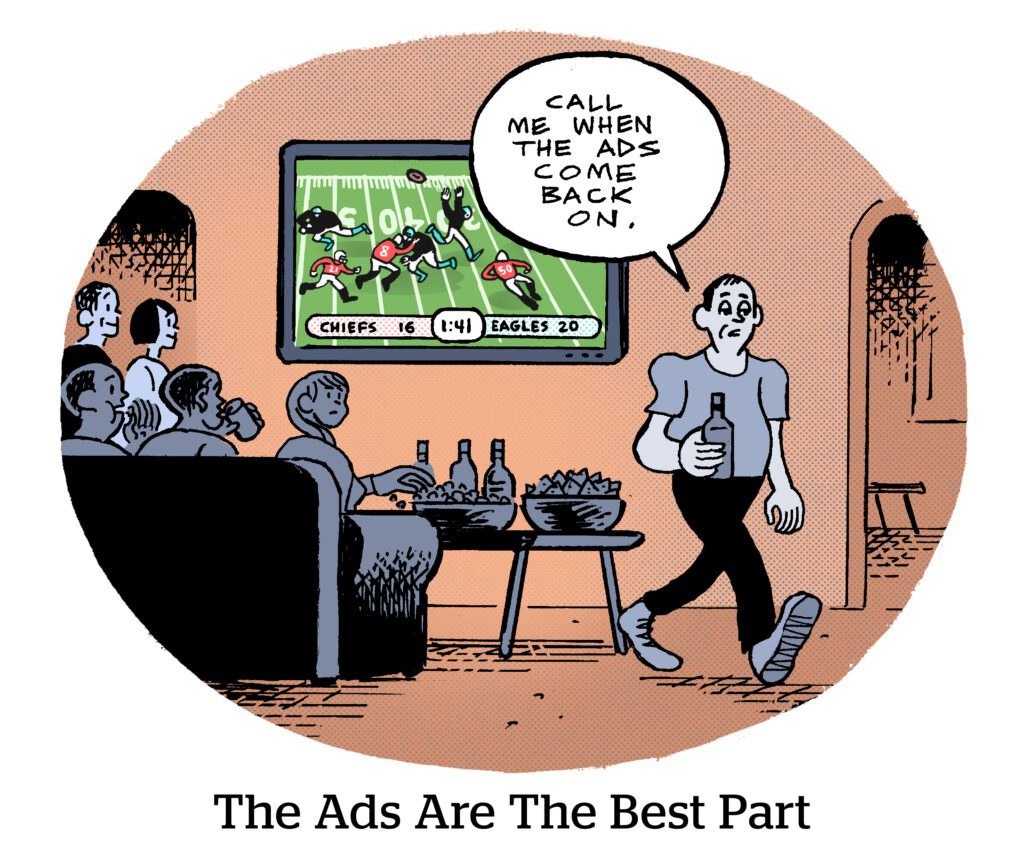The Super Bowl has always been a cornucopia for multimillion-dollar TV commercials, in part because of the sheer number of people who tune in just for the ads.
But that number is dwindling. About 25% of those planning to watch the Big Game this year are there for the ads, a drop from 34% last year, according to a recent report from Adtaxi. More people are interested in the game itself or the halftime show. (Taylor Swift was not an option in the poll.)
Behind waning enthusiasm for Super Bowl ads is the fact that they don’t impress Gen Z all that much – nor does broadcast or cable TV, for that matter. Sure, young people will catch the game by streaming it on Paramount+, but they’ll also be focusing on social media for updates and chatter around the game, including celebrity turnout.
Of course, there is value in reaching a captive, highly engaged audience of over 100 million viewers – but to maximize ad budgets, advertisers have to do more than just spend millions on a 30- or 60-second spot. They need to keep up online and social marketing before, during and after the game, especially to reach Gen Z. Using influencers will help, too.
The shifting dynamic may explain why some major Super Bowl regulars are absent this year: GoDaddy, Ford, General Motors and Chrysler parent company Stellantis, to name a few.
The playing field
Food, sports betting and direct-to-consumer brands make up the bulk of this year’s commercial lineup.
First-time Super Bowl advertisers include Lindt, e.l.f., BetMGM, Popeyes, Drumstick and Nerds. They join a fairly long list of returning advertisers: FanDuel, Reese’s, Pringles, Oreo, BMW, Skechers, T-Mobile, TurboTax, Booking.com and Anheuser-Busch InBev, among many others.
A celebrity cast isn’t new to advertisers that have tried to grab the attention of millennials watching the Super Bowl. But this year, brands are dialing up their partnerships with influencers and TV stars who are well-known to Gen Z. Expect to see Jenna Ortega, Judy Sheindlin, John Cena and actor-comedian Eric André repping Doritos, e.l.f., FanDuel and Drumstick, respectively. (Other celebrity callouts: Chris Pratt, Kate McKinnon – and “Mayo Cat,” of course – Pete Davidson, Kris Jenner, Jennifer Aniston and TikTok influencer Addison Rae.)
Advertisers are also crossing their fingers that Taylor Swift’s appearance at the game will boost ad recall and effectiveness – assuming she makes it to Las Vegas in time from her tour in Japan on Saturday. (If only I had a dollar for every “Swift Effect” pitch sitting in my inbox.)
Sphere of influence
But brands that want to really resonate with Gen Z – as in, have a material impact on ad recall and brand consideration – are going to be active on search and social media.
A majority of consumers planning to stream the Super Bowl say they’ll also be using social media during the game, according to Adtaxi’s report. And advertisers will have a better chance of winning online conversions if they build up purchase consideration beforehand with a social media presence – especially if that social media presence involves influencers. Tums and Invisalign are two examples of brands tapping influencers and comedians for social media campaigns leading up to the game.
Gen Z favorite TikTok will grab onto the promotional opportunity, too. Expect to see TikTok Shop “pushing more promotional deals targeted to the Super Bowl and linking to deals that will expire around the time of kickoff,” says Forrester Principal Analyst Audrey Chee-Read.
Meanwhile, other online and social campaigns will extend past this weekend to capitalize on the lingering enthusiasm.
Here’s a fun fact: Online searches for the Super Bowl peak the day after the Big Game, not the day of, according to recent research from Tracer.
For days after the game, viewers will be searching for the influencers they saw on-screen, the brands and products those celebrities helped promote and, of course, reruns of the ads themselves.
We’ll see who can score touchdowns with viewers this weekend – and particularly with Gen Z. 🏈
Are you enjoying this newsletter? Let me know what you think. Hit me up at alyssa@adexchanger.com.














